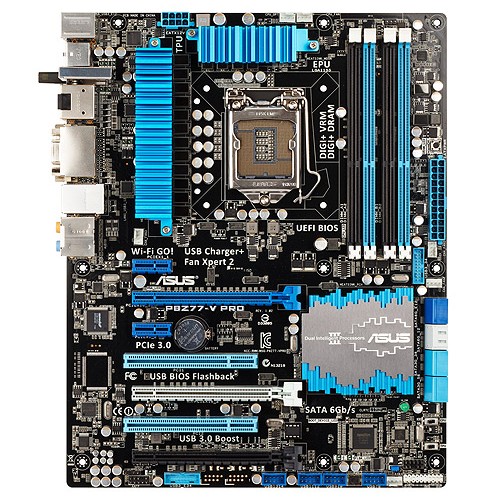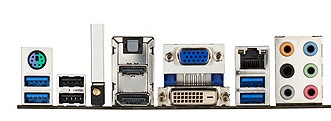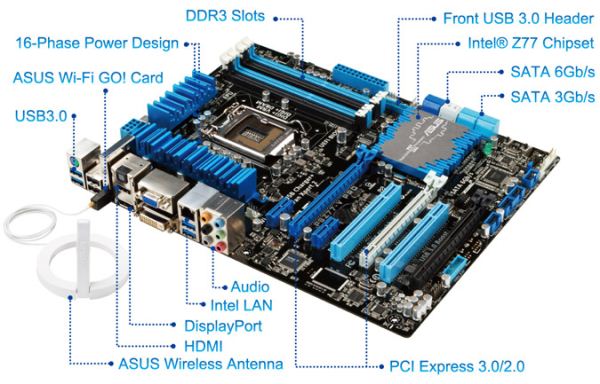Intel Z77 Panther Point Chipset and Motherboard Preview – ASRock, ASUS, Gigabyte, MSI, ECS and Biostar
by Ian Cutress on April 8, 2012 12:00 AM EST- Posted in
- Motherboards
- Intel
- Biostar
- MSI
- Gigabyte
- ASRock
- Asus
- Ivy Bridge
- ECS
- Z77
ASUS P8Z77-V Pro—Visual Inspection
ASUS have a lot to live up to with its Ivy Bridge Pro board. Both the ASUS P8P67 Pro and ASUS P8Z68-V Pro have been top class sellers in their respective chipsets, meaning that ASUS has to deliver. Thankfully, by just looking at the board, it seems that ASUS is keen to innovate and offer a complete package.
Using a 12 + 4 VRM power delivery system, the ASUS P8Z77-V Pro sports a blue and black livery synonymous with their channel / non-ROG products. The VRM heatsinks cover a lot of surface area in their jagged fashion, and around the socket itself, we have access to five main fan headers. Two of these are CPU 4-pin headers just north of the top VRM heatsink, one 4-pin below the left hand side VRM heatsink, and two 4-pin headers below the 24-pin ATX power connector, along with a USB 3.0 port. A sixth fan header (4-pin) is found on the south side of the board.

Above the 24-pin ATX power connector, we find the ASUS MemOK! button, which allows memory recovery to default speeds. Along with the ASRock boards, we have eight SATA ports—four SATA 3 Gbps from the PCH and four SATA 6 Gbps—two from the PCH and two more from an ASMedia controller. Below this are the TPU and EPU switches, designed for enhanced CPU performance and energy saving modes respectively.

Along the bottom of the board is the standard array of a front panel audio header, another USB 3.0 header, USB 2.0 headers, and a front panel header. In terms of PCIe layout, despite there being three full-length PCIe connectors on board, we are only limited to using two for multi-GPU setups. In order, we have a PCIe x1, a PCIe 3.0 x16 (x8 in dual GPU), x1, PCI, PCIe 3.0 x8, PCI, and a PCIe 2.0 x4. Thus in dual GPU mode, similarly to the ASRock Extreme6, we can also add in a PCIe x1 and PCIe x4 card.
The chipset heatsink is indicative of the large but low philosophy of many motherboard manufacturers, hiding away the chipset controller. What is not on these boards, as you may notice, is a combination power/reset pair of buttons, nor a two-digit debug, some of which we used to see on ASUS Pro boards of old. Nevertheless, the ASUS board in return makes up for it on the back IO panel.

On the back panel, we have a combination PS/2 port, two USB 3.0 ports (blue), two USB 2.0 ports (black), an ASUS Wi-Fi GO! Card, optical SPDIF output, HDMI, DisplayPort, D-Sub, DVI-D, gigabit Ethernet, two more USB 3.0 ports in blue, and standard audio headers.
This means that rather than add in a WiFi module on the board, or use up a mini-PCIe slot with wifi, we have a slot in order to add a WiFi module. This can be in 2.4 GHz or 5 GHz mode, and updateable as WiFi standards change. This all comes as part of the package, with magnetic wireless antenna to attach to the case.
Board Features
| ASUS P8Z77-V Pro | |
| Size | ATX |
| CPU Interface | LGA-1155 |
| Chipset | Intel Z77 |
| Power Delivery | 12 + 4 |
| Memory Slots |
Four DDR3 DIMM slots supporting up to 32 GB Up to Dual Channel |
| Video Outputs | DisplayPort, HDMI 1.4a, DVI-D, D-Sub |
| Onboard LAN | Intel 82579V |
| Onboard Audio | Realtek ALC892 |
| Expansion Slots |
2 x PCIe x16 Gen3 (x16, x8/8) 1 x PCIe x16 Gen2 (x4) 2 x PCIe x1 Gen2 2 x PCI |
| Onboard SATA/RAID |
2 x SATA 6 Gbps (PCH), Support for RAID 0, 1, 5, 10 2 x SATA 6 Gbps (ASMedia) 4 x SATA 3 Gbps (PCH), Support for RAID 0, 1, 5, 10 |
| USB |
Four USB 3.0 at rear (2 PCH, 2 ASMedia) Two USB 3.0 headers on board (PCH, ASMedia) Ten USB 2.0 (2 back panel, 8 on board) |
| Onboard |
4 x SATA 6 Gbps 4 x SATA 3 Gbps 2 x USB 3.0 Headers 4 x USB 2.0 Headers 6 x Fan Headers 1 x SPDIF Header 1 x Front Panel Audio Header MemOK! Button TPU/EPU Switches USB Flashback Button |
| Power Connectors |
1 x 24-pin ATX connector 1 x 8-pin 12V connector |
| Fan Headers |
1 x CPU Fan Header (4-pin) 4 x CHA Fan Headers 1 x OPT Fan Header |
| IO Panel |
1 x PS/2 Combo Port 1 x DisplayPort 1 x HDMI 1.4a 1 x DVI-D 1 x D-Sub 1 x Gigabit Ethernet 4 x USB 3.0 2 x USB 2.0 1 x Optical SPDIF 1 x WLAN Connector 6 x Audio Jacks |
| Warranty Period | 3 Years |
| Product Page | Link |
ASUS as a direct standard are now placing Intel NICs on all their channel motherboards. This is a result of a significant number of their user base requesting them over the Realtek solutions. Also to note are a total of six USB 3.0 on board, two on the back panel and four from internal headers. These USB 3.0 ports can take advantage of the improved UASP USB 3.0 protocol using appropriate hardware and some ASUS software. As always, we expect ASUS fan control of the six headers to be top notch.











145 Comments
View All Comments
tyger11 - Sunday, April 8, 2012 - link
The article says only 2 USB 3.0 ports, but the table indicates 4. Which is correct?repoman27 - Sunday, April 8, 2012 - link
I didn't see your comment and posed a similar question, but I'm fairly certain the answer is that there are actually 4 SuperSpeed ports provided by the 7-series chipsets. If you look at the block diagram shown for the Intel DZ77GA-70K motherboard it looks like they clearly used two 3-port USB 3.0 hub chips to arrive at a total of 8 USB 3 ports. Which also brings up the point that by leveraging the integrated USB 3.0 capabilities, motherboard manufacturers can add as many USB 3.0 ports as they like by using far less expensive hub chips instead of full blown controllers which also require a PCIe lane apiece.And speaking of PCIe, I also wonder about where Ian says, "These are known as PCIe 3.0 PLX PXE chips..." I'm guessing that he's referring to PLX's PEX 874x Gen 3 PCIe switches, but it's stated a bit oddly.
landerf - Sunday, April 8, 2012 - link
Is the wifi card on the deluxe going to be accessible? Be nice to get a killer 1102 in there.johnpombrio - Sunday, April 8, 2012 - link
Yeah, the WiFi connection(s) on the ASUS Pro and Deluxe depends on a small WiFi module that plugs into a particular slot. These will be interchangeable AND I have seen ASUS showing off a WiFi/ 60GB SSD drive going into that slot. The Pro looks like just a receiver while the Deluxe has a WiFi router built in but I am REALLY guessing on this. I think I will go with the Deluxe just because it has a couple of features I like and the WiFi router combo will be just gravy.ASUSTechMKT - Monday, April 9, 2012 - link
Our MCombo Card ( which is on the Maximus V Gene and upcoming Formula should not be confused with the solution on our channel boards ( Standard -V, Pro or Deluxe ). The MCombo will allow you to install any MiniPCI-E or MSATA cards into their corresponding slots.ASUSTechMKT - Monday, April 9, 2012 - link
The module which connects to the back I/O panel can be opened. While not promoted as being DIY there is nothing stopping you from installing your own mini PCI-E wireless controller.AlexIsAlex - Sunday, April 8, 2012 - link
I know I've asked for this before, but if you're going to do a big roundup of all these motherboards (which I'm looking forward to, as I plan to upgrade to Ivy Bridge on release), then please please test the boot / POST times to compare between the boards!Just the time it takes from hitting the power switch to when it starts to actually run the bootloader off disk. Or until it displays the "please insert boot media" - the actual time the bios contributes to the total boot time. This is something that can really differentiate between different bios implementations and would be really useful to know when choosing.
I know having RAID and on board devices turned on make a big difference, so a baseline of everything non-essential turned off, or just those devices that are present on all boards would make sense.
Nihility - Sunday, April 8, 2012 - link
Seriously, please test POST times!Especially with the 6 Gbps Marvel controllers. Those damn controllers can take over 10 seconds to boot. That can easily be as much as the entire system.
risa2000 - Sunday, April 8, 2012 - link
I would be quite interested in this one.eXces - Sunday, April 8, 2012 - link
would be very pleased for an ITX review! Especially Asus P8Z77-I DeluxeThx